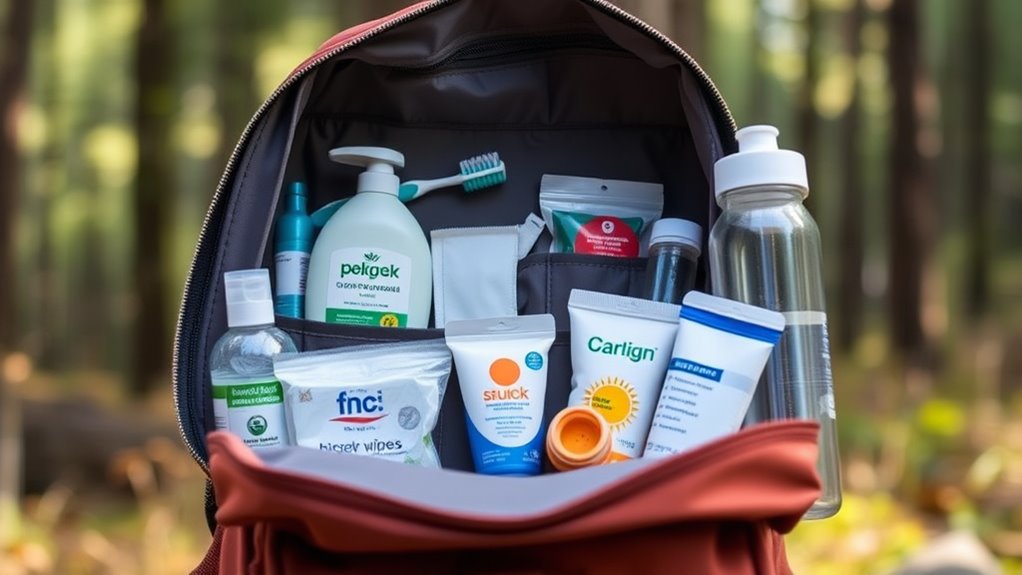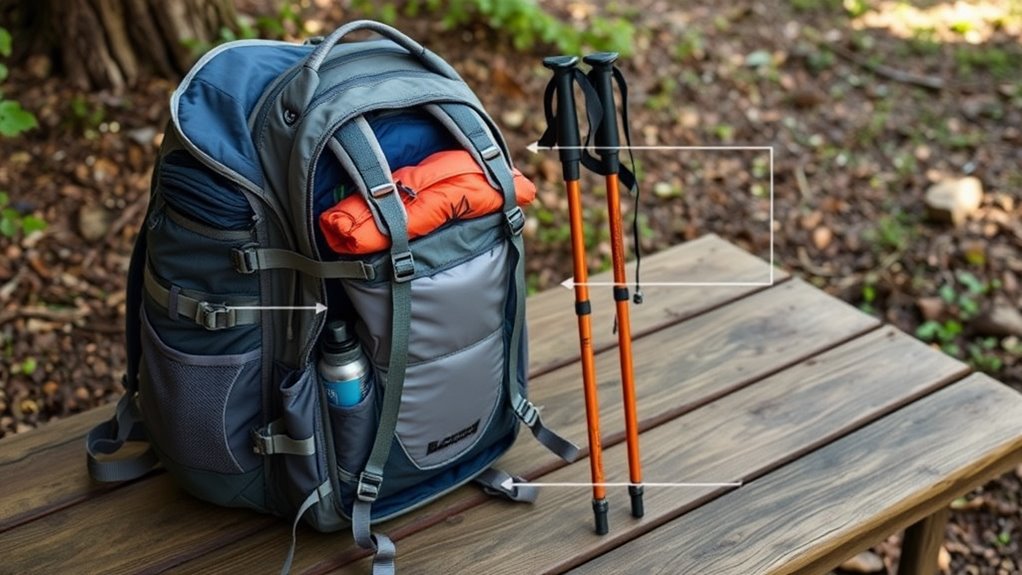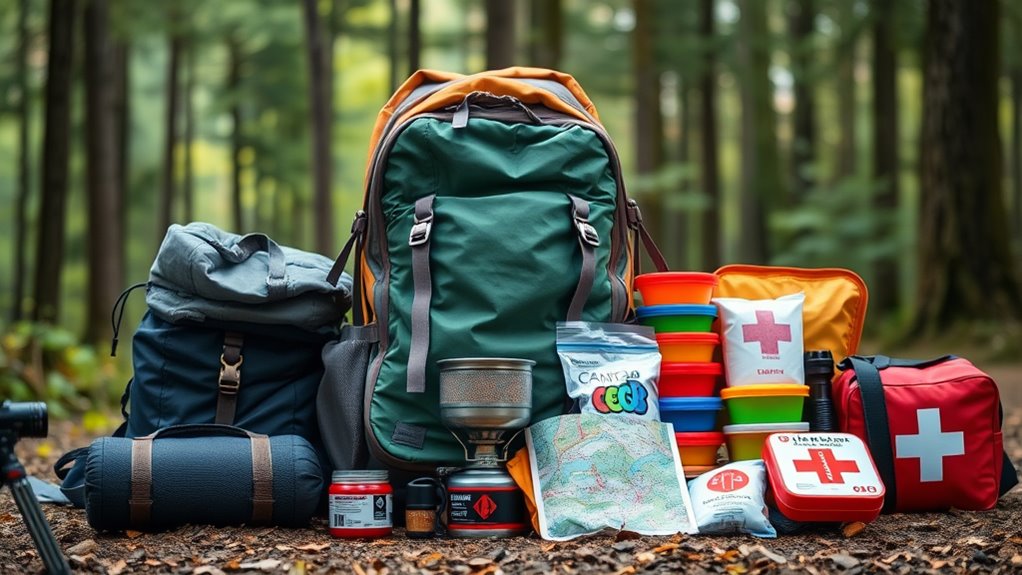How to Pack a Backpack for a Weekend Camping Trip
This post contains affiliate links. As an Amazon Associate, we earn from qualifying purchases.
To pack your backpack for a weekend camping trip, start with a 40 to 70-liter pack. Organize your clothes using packing cubes and roll lightweight items for efficiency. Pack toiletries in a ziplock to avoid spills and include essentials such as a first aid kit. Distribute weight evenly, placing heavier items in the middle and essentials like your rain jacket at the top for easy access. Stick around to discover more tips for a successful trip!
Key Takeaways
- Choose a backpack with a capacity of 40 to 70 liters, ensuring it has adjustable straps and a padded hip belt for comfort.
- Organize clothing using compression bags or packing cubes, rolling lightweight fabrics and folding thicker items for space efficiency.
- Pack essential toiletries in a clear ziplock bag and include a first-aid kit for minor injuries during the trip.
- Distribute weight by placing heavier items like the tent in the middle of the pack and keeping the sleeping bag at the bottom.
- Always keep essential items like the first-aid kit, rain jacket, and snacks at the top for easy access while hiking.
Choosing the Right Backpack
When you’re choosing the right backpack for a weekend camping trip, aim for one with a capacity between 40 to 70 liters. This size will comfortably hold all your necessary gear.
Look for adjustable straps and a padded hip belt to guarantee comfort and proper weight distribution while you hike. It’s also wise to select a water-resistant backpack or one with a built-in rain cover to safeguard your gear against moisture and unpredictable weather.
Prioritize backpacks with multiple compartments and pockets, making it easier to pack your backpack efficiently and keep everything organized.
Finally, consider the pack’s weight; lightweight designs help you avoid unnecessary bulk while still ensuring durability for rugged use.
Clothing Selection and Organization
When packing for your camping trip, focus on versatile clothing that can adapt to different weather conditions.
Efficient packing techniques, like using compression bags or packing cubes, will help keep your gear organized and accessible.
Versatile Outfit Choices
Choosing the right clothing for your camping trip can make all the difference, especially if you prioritize versatility. Pack versatile clothing items like lightweight long-sleeve shirts, quick-dry shorts, and a durable jacket. These can be layered and mixed-and-matched, maximizing outfit options while minimizing bulk.
Limit yourself to one pair of jeans or durable pants for various activities, ensuring comfort. Dresses or skirts can be dressed up or down, saving space in your backpack.
Use packing cubes to keep everything organized; roll lightweight fabrics to save space and fold thicker clothing. For easy access, stuff smaller items like socks and chargers inside your shoes, utilizing every bit of available space efficiently.
Efficient Packing Techniques
Packing efficiently for your camping trip not only makes your backpack lighter but also keeps you organized and ready for anything.
Start by selecting versatile clothing items that you can layer and use for multiple occasions. Use packing cubes or large ziplock bags to categorize your clothes, making everything easy to access.
Roll lightweight fabrics like t-shirts and leggings for space efficiency, while folding thicker items like sweatshirts. Wear your heaviest clothing during travel to save space, and stuff smaller items inside your shoes.
Keep toiletries in a designated waterproof dry bag for organization.
- Layered clothing for warmth
- Packing cubes for organization
- Rolled lightweight items
- Heaviest clothing worn
- Small items stuffed inside shoes
Toiletries and Personal Care Items

When packing your toiletries, focus on travel-sized liquid items like shampoo and body wash to keep your backpack light.
Don’t forget your personal care essentials such as toothpaste and a toothbrush; you’ll want these handy during your trip.
Organizing everything in a clear ziplock bag can save you time and prevent spills.
Essential Liquid Toiletries
To make your camping trip more enjoyable, limit your liquid toiletries to just the essentials. Most campsites provide basic items, so you won’t need to overpack.
Use a clear zip lock bag to organize your toiletries, making it easier to find what you need and speeding up security checks if you’re traveling.
Here are some must-have liquid toiletries to contemplate:
- Travel-sized shampoo
- Conditioner
- Body wash
- Lotion
- A mini perfume
Don’t forget to include personal items like toothpaste and lip balm to help you feel fresh.
Also, think about adding small skincare products like vitamin-C oil to support your skin during outdoor activities.
And remember to pack any specific hygiene items you may require!
Personal Care Must-Haves
While preparing for a camping trip, having the right personal care items is essential for maintaining comfort and hygiene in the great outdoors.
Start by packing travel-sized toiletries like shampoo, conditioner, and body wash in a clear ziplock bag—this makes security checks easy and saves space in your backpack.
Don’t forget your personal care must-haves such as toothpaste, lip balm, and a toothbrush to keep your mouth fresh.
A small first-aid kit with Band-Aids and tweezers is vital for addressing minor injuries.
Pack a compact mirror and hair ties for grooming convenience, especially if you have long hair.
Finally, consider including a vitamin-C oil to protect your skin from the elements. A pack cover can also safeguard your essentials from unexpected weather.
Packing Essential Gear and Equipment
Packing essential gear and equipment efficiently can make a significant difference in your overall camping experience. Start by laying out all your items to determine what’s necessary, helping you keep everything lightweight.
Use compression sacks for your sleeping bag and clothing to save space. Store heavier items, like the stove and food, in the middle of your pack for better stability. Keep essential items, including a first-aid kit, rain jacket, and snacks, at the top for easy access while hiking.
Don’t forget to pack small items, such as a multi-tool and chapstick, in your hip belt pockets for quick retrieval.
- Compression sacks
- First-aid kit
- Rain jacket
- Snacks
- Multi-tool
Utilizing External Attachment Points

After organizing your gear inside the backpack, it’s time to take advantage of the external attachment points that many packs offer.
These points, like daisy chains and side loops, make it easy to secure items such as sleeping pads, tents, or trekking poles for quick access during hikes.
When attaching gear, be careful not to overload these points, as too much can snag on branches and disrupt your balance while you move around.
Use gear ties and lightweight carabiners to keep things secure without taking up internal space.
Regularly check that everything is tightly fastened to avoid losing items on the trail.
With a little thought, you can enhance your packing efficiency and enjoy a smoother hiking experience.
Final Packing Assembly and Tips
To guarantee a successful camping trip, start your final packing assembly with strategic placement of your gear.
Begin with your sleep system: tuck your sleeping bag at the bottom for balance and easy access. Layer heavier items, like the tent and cooking gear, in the middle section to keep weight close to your back. Place essentials, such as the first-aid kit and rain jacket, at the top for quick retrieval.
Consider these tips:
- Use external attachment points for bulky items.
- Organize smaller items in color-coded dry bags.
- Avoid over-packing to ascertain you have extra room.
- Keep anything in your pack secure yet balanced.
- Pack with intention to make your trip enjoyable.
Conclusion
By following these packing tips, you’ll be well-prepared for your weekend camping trip. Choosing the right backpack and organizing your clothing, toiletries, and gear guarantees you have everything you need without unnecessary weight. Don’t forget to make use of those external attachment points for extra items. With your backpack packed efficiently, you can focus on enjoying the great outdoors and making unforgettable memories. Now, grab your gear and hit the trail!

